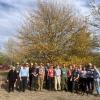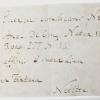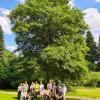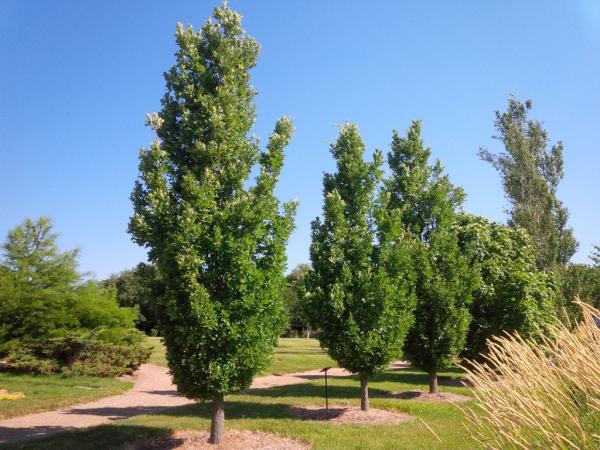Editor's Picks
Plant Focus
Though the Oak Open Days event began officially in Canberra on the morning of May 8, many participants attended the Friends of ACT Trees "Tree Week" Dinner the evening before. The Friends of the ACT Trees (FACTT) is a group of individuals with an interest in the trees in Canberra's landscape and environs, and aims to foster sound management and appreciation of arboreta in the Canberra region. Every May, the City of Canberra celebrates Tree Week, providing an opportunity for the community to learn more about the value of trees in Canberra. The Tree Week dinner is a regular feature and includes a presentation by an invited speaker. On this occasion it was IOS President Roderick Cameron, who discussed possible species of oak that could be trialled in Canberra’s already highly diverse and oak-rich urban canopy.
The following morning, we met at Royal Canberra Golf Club for a tour of Westbourne Woods, a historic arboretum located in the suburb of Yarralumla. It was established in 1913 by T.C.G. “Charlie” Weston, Canberra’s first Superintendent of Parks and Gardens, who used gelignite to blast planning holes, as he believed trees grew better in fractured soil than in hand-dug holes. Paul Scholtens of FACTT guided us to some interesting oaks in between the fairways, as kangaroos hopped by. Notable oaks included some mature Quercus chrysolepis, fruiting copiously, that seemed quite at ease despite being far from their Californian home.

From there, Peter Marshall led us to the National Arboretum Canberra, just outside the city, for a wander through a remarkable planting of cork oak (Q. suber). The trees were grown from acorns imported from Spain in 1917 by Walter Burley Griffin, the city’s architect. They were planted by T.C.G. Weston and the planting is said to be the largest of its type in the Southern Hemisphere. Since 1981 the cork has been harvested, in some cases with the help of Portuguese professional cork strippers.
This “cork oak forest” appears to be the inspiration for the National Arboretum, which consists of 94 large single-species group plantings. Several oak species are featured: Q. engelmannii, Q. macrocarpa, Q. robur, and the interesting but as yet unregistered cultivar Q. palustris ‘Freefall’, selected for its tendency to drop all its leaves quickly in autumn.

In the afternoon, we saw a fine planting of Q. phellos on Linnaeus Way in the Australian National University, with its foliage combining green and yellow leaves as it turned color.
Next, we visited the Old Parliament House to view the impressive Speaker’s Chair, a replica of the Speaker’s Chair in the Palace of Westminster in London. carved from oak and timbers from Westminster Hall and HMS Victory, Admiral Nelson’s flagship at the Battle of Trafalgar.
Peter Marshall showed us some of Canberra’s plantings of unusual species of oaks, including Q. gambelii, Q. engelmannii, Q. douglasii, and Q. lobata, and in between, we drove up to Mount Ainslie Lookout for a magnificent view of Canberra.

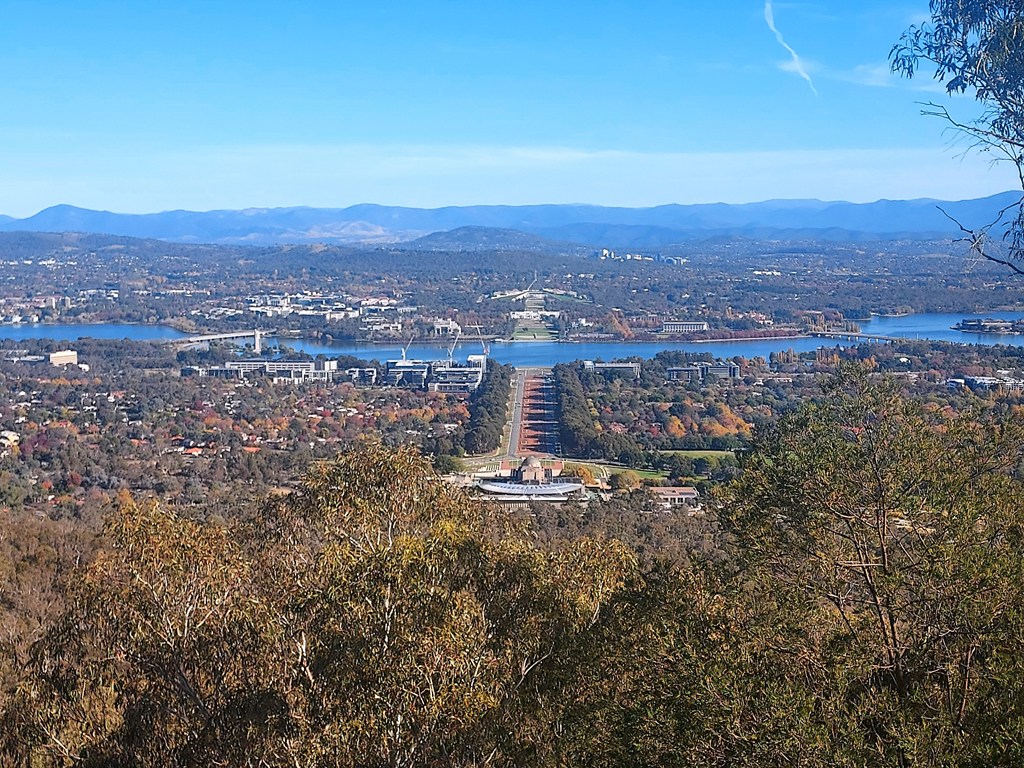
The day ended at St. Ninian’s Uniting Church, under a fine and freely fruiting Q. canariensis, a species remarkably common in Australia.

On Friday, May 8, we drove out to Braidwood, about an hour’s westward drive from Canberra. After a welcome coffee under a large Q. robur in the town square, we drove out to Peter Marshall’s property, where he showed us his planting technique for establishing oaks, deep ripping with a Yeoman’s Plow and adding mycorrhizal fungi, then planting some Q. leucotrichophora seedlings that will soon grace a newly acquired plot of land.
(The video above is best viewed on YouTube)

A delicious lunch kindly hosted by the Marshall family was followed by an awe-inspiring demonstration of their remote-control mulcher, which clears apparently impenetrable bush in a matter of minutes, following by a visit to their truffle patch. We saw how Peter burns pruned branches in partial top-down burns that produce charcoal rather than ash, increasing soil fertility, and we were treated to a truffle hunt led by Aldo, their expert truffle dog.
Before departing Braidwood, some of the group viewed an old Q. suber growing in a garden by the main road, said to have been brought out in a Wardian Case and planted in 1842.

The following day was dedicated to travelling from Canberra to Melbourne for the second leg of the Oak Open Days. We travelled independently, and a group led by event-leader Peter Berbee of Royal Botanic Gardens Victoria stopped at Albury Botanic Gardens, where we debated the identity of a large tree planted in 1908 and identified on its plaque as “Quercus ballota – The Barbary Oak – S.W. Europe”. Quercus ballota is a synonym of Q. rotundifolia, but the tree is certainly not that. We suspected it may be Q. canariensis: “Barbary” is derived from Berber, the indigenous people of North Africa, where Q. canariensis is native.

The next day, we drove out east to Dunkeld to visit Mereweather Estate, where oak enthusiast Bill Funk has established one of the largest private collections of trees in Australia, including an impressively comprehensive collection of oaks. Bill is a farmer growing Merino sheep for wool. After planting shelter belts for stock protection, he started planting exotic trees in 1973. Since then, he has cultivated over 200 species of oak in an arboretum extending over some 75 hectares.
After a welcome lunch, we spent the afternoon exploring the collection, which includes many rarely seen species, especially from East Asia, West Asia, and Mexico. Bill collected personally in China, but seed was sent to him from around the world, before quarantine regulations made the practice all but impossible in Australia. Standouts included Q. pannosa, Q. franchetii, Q. alnifolia, Q. elliptica, Q. uxoris, Q. calophylla, Q. crassifolia, among many more.

We spent the evening in nearby Hamilton, where the local botanic gardens, designed in 1881 by William Guilfoyle, designer of the Botanic Gardens Melbourne, hold an outstanding Q. leucotrichophora, about 100 years old and measuring 16 m tall with a 90 cm dbh.
On Monday, we were back in Melbourne to visit the Royal Botanic Gardens Victoria. We congregated at the site that used to be occupied by a large Q. alba, which failed over Christmas 2019, now occupied by what appears to be a Q. rysophylla hybrid. Our visit began with a tour of the herbarium, including a display of choice oak specimens especially laid out for us.
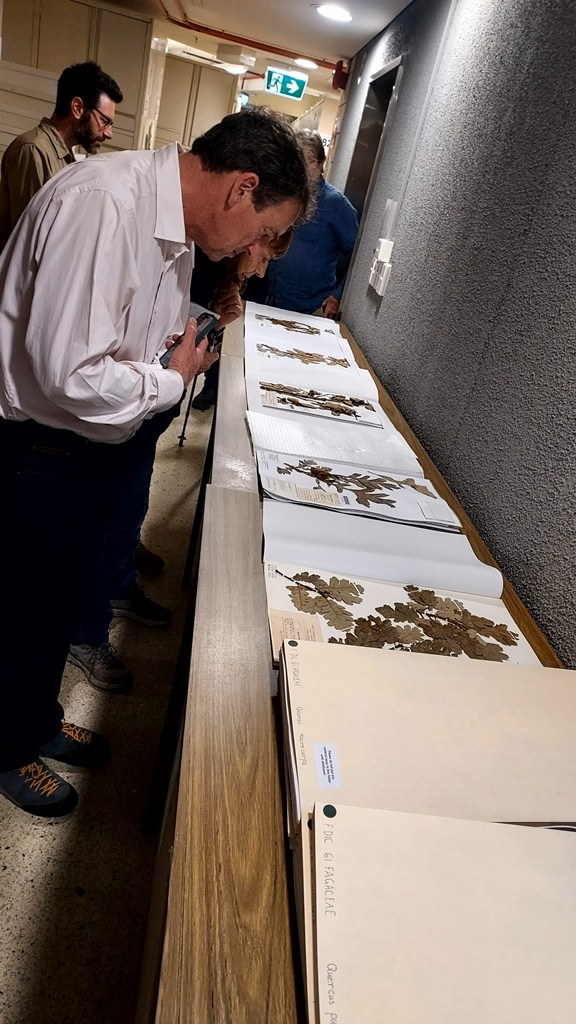
The herbarium houses important specimens, including duplicates of several type specimens, such as a syntype of Q. engleriana. Our tour of the gardens featured several impressive mature oaks, among them Q. frainetto, a massive Q. canariensis, a fastigiate Q. canariensis hybrid, Q. robur Purple-Leaf Group ‘Atropurpurea’, as well as a young Q. engelmannii, grown from seed recently imported from California.

The showstopper, however, was a young tree of the rare Q. bambusifolia, which was in full flower, unusual of course for mid-autumn in Melbourne, but perhaps a reflection of its tropical origins (Hong Kong, southeastern China and northern Vietnam).

For the last day of the event we drove out to Hoddle’s Creek to view the late Geoff Bogle’s arboretum. This is a little-known gem of an arboretum, created by a plant enthusiast who once grew Christmas trees for supermarkets but then started collecting trees of all kinds for his personal arboretum.
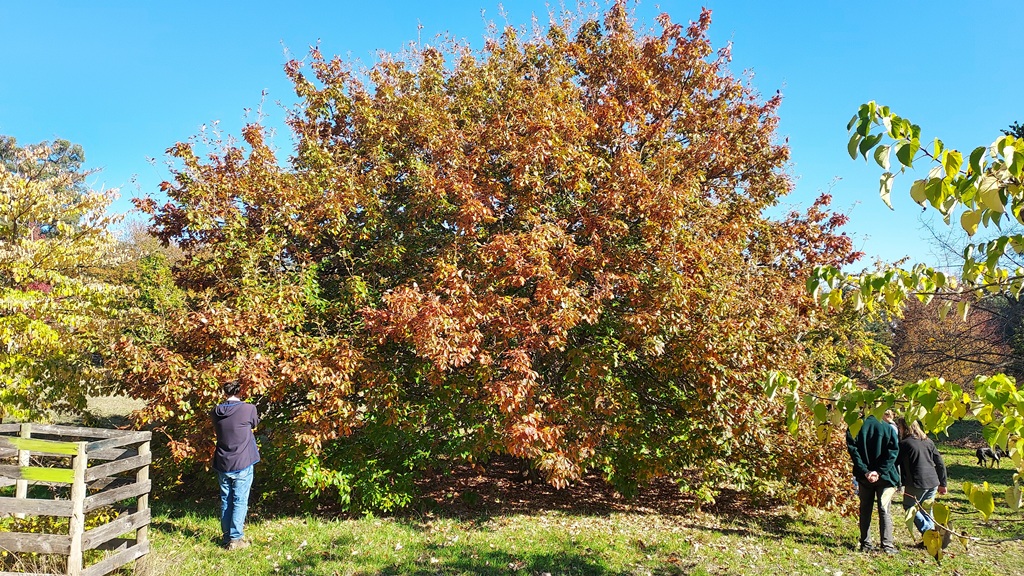
The arboretum is on a 32-hectare property, where Geoff began planting trees in 1985. It now has over 4,000 different trees and shrubs, among them 1,750 conifers, 230 oaks (158 species, the rest hybrids and cultivars), and 158 maples. We were guided round the arboretum by Don Teese, nursery manager and IOS member, who knows the arboretum well, and John O'Hara, the current owner of the property.
The oak collection has some outstanding specimens. An arbitrary selection of ones that particularly made an impression would be: Q. longinux, Q. pentacycla, Q. aliena ‘Lutea’, a striking cultivar with caramel-yellow leaves, rare in cultivation outside Japan (the voice-over in the video above incorrectly states it is only found in Australia; read more about it here), a large Q. rysophylla that competes with champion trees in cultivation, and a variegated yellow-leaved Q. suber selection.

As evening fell, we moved to Kallista Village and viewed a mysterious hybrid known in Australia as Q. ‘Firthii’ or the Macedon oak. It appears to be one of a group of hybrid oaks traceable to an original tree that grew on a property near Mount Macedon, Victoria, apparently a cross between Q. palustris and another section Lobatae oak. It has attractive foliage, reminiscent of the series Acutifoliae of Mexican Red Oaks, and which is often evergreen.
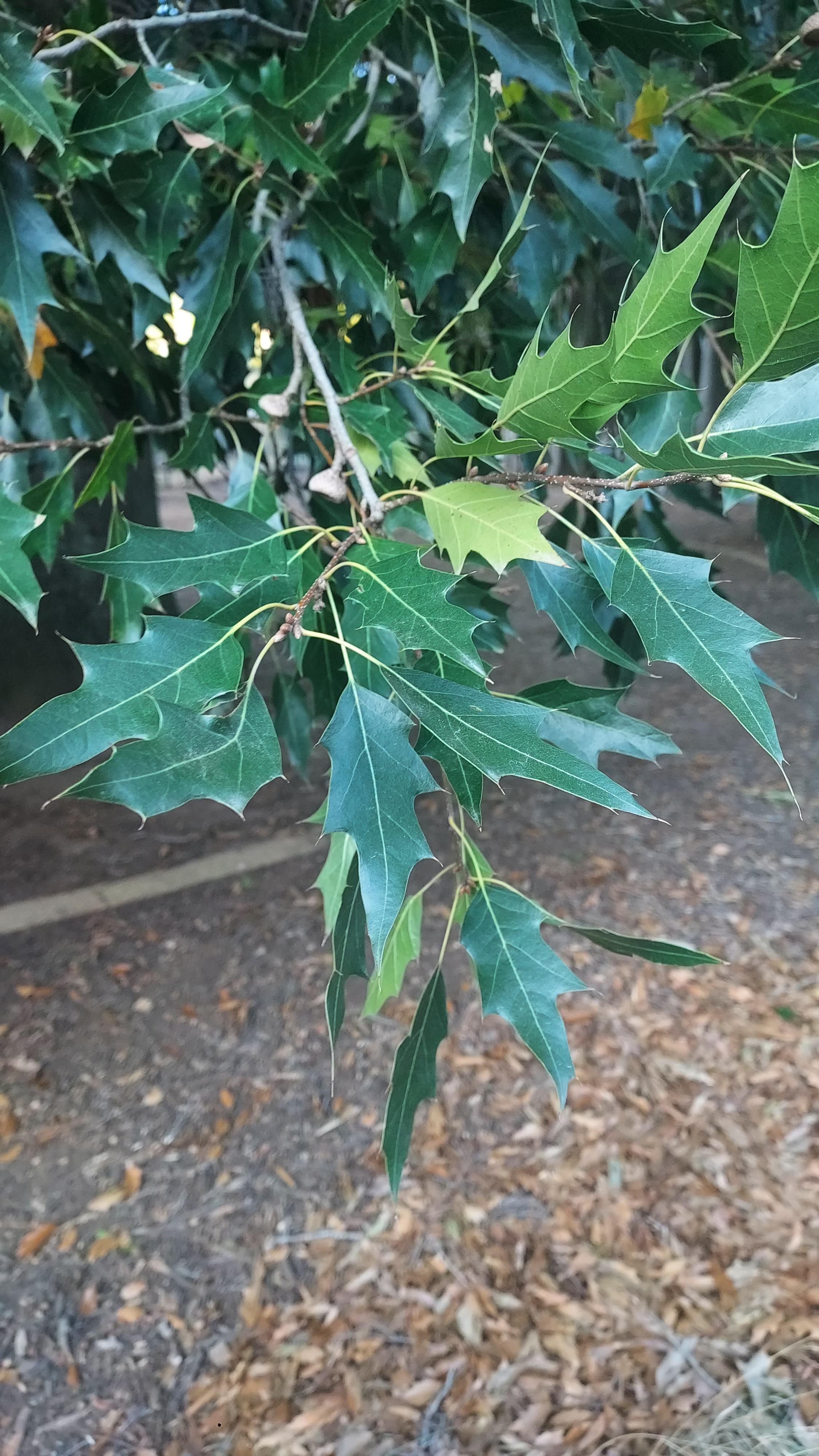
The trees in cultivation under this name seem to be seedlings of the original or its descendants, so there is a certain amount of variation. You can learn more about this odd oak in Tim Entwistle’s blog here or in a video here.
The day’s activities were drawn to a close with a brief visit to Glen Harrow Gardens in Belgrave, originally a 19th-century nursery. Some impressive trees survive from the nursery days: Q. leucotrichophora, Q. canariensis, Q. stellata, Q. acuta, Q. ilex, and the oak relative Castanopsis cuspidata. This was followed by a farewell tea kindly hosted by Don and Sue Teese at their home.
So ended a highly successful Oak Open Day event, our first in Australia, attended by 17 registered participants, 6 guides and hosts, and several more guests. Huge thanks to Peter Berbee and Jo Brennan for organizing the event, to Peter Marshall for guiding us in Canberra and hosting us in Braidwood, to Bill Funk for receiving us at Mereweather Estate, and to Don Teese for taking care of us on the final day. There was immense enthusiasm in the group, and plans have been laid for a local association or chapter. Watch this space!
Updated August 25, 2025, to correct details of where Q. aliena 'Lutea' is found.

